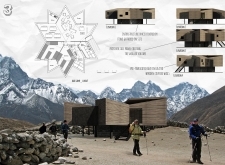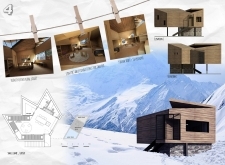5 key facts about this project
## Project Overview
The Himalayan Mountain Hut is situated in the challenging terrain of the Nepalese Himalayas, designed to provide shelter for trekkers and adventurers. The intent is to create a functional living space that offers comfort while harmonizing with the region's unique environmental and cultural attributes. The design seeks to accommodate both individual needs and communal activities, making it a versatile refuge in an extreme climate.
### Aesthetic and Structural Elements
The hut features a distinctive star-shaped layout, facilitating multiple orientations that enhance views of the surrounding landscape. This petal-like configuration draws inspiration from local flora, reflecting the characteristics of the Himalayas while promoting both aesthetic appeal and structural integrity. The modular design allows for various uses, including community interactions and private sleeping spaces, optimizing the hut's versatility and usability.
### Materials and Environmental Consideration
Sustainably sourced wood serves as the primary construction material, enhancing the hut's natural warmth and aesthetic. Local stone is employed in foundational elements to ensure stability and a strong connection to the site. The integration of photovoltaic panels supports modern amenities while minimizing reliance on non-renewable energy. Insulated panels are also utilized to provide essential thermal comfort, addressing the temperature extremes common in the high-altitude environment. These material choices reflect a commitment to sustainability by reducing the carbon footprint and responding effectively to the challenges posed by the mountainous landscape.




















































